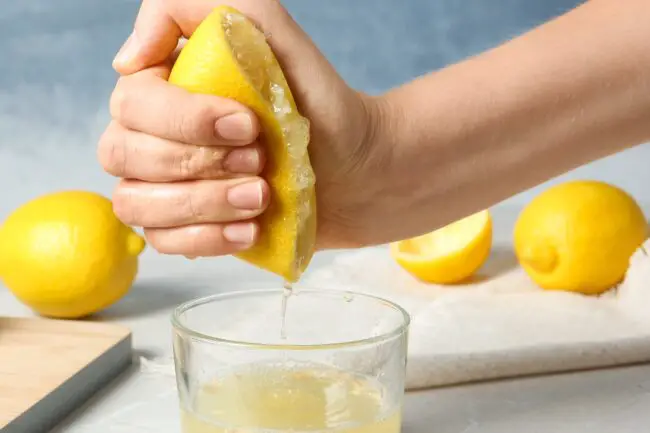
There is probably no beverage that entices the palate on a hot summer day as much as a cool glass of sweet-tart lemonade. It is the drink of fair grounds, carnivals, porch swings, southern hospitality, swimming holes, sprawling trees draped with Spanish moss and memories of mother. It’s the quintessential drink of summer.
There’s something about the sight of a glass jug of lemonade, filled with ice and dripping with condensation that makes you want to gulp it down. And the popularity of lemonade has endured: the origin of the all-American lemonade has its roots in medieval Egypt.
Regrettably, many of us shy away from lemonade due to its high sugar content and choose beverages such as unsweetened iced tea instead. It’s true that unsweetened lemonade would be an assault to the taste buds and store bought lemonade has a lot of sugar. But you can make your own lemonade at home—and suit the sweetness to your taste. Let us teach you how to make the perfect summer lemonade.
Lemonade basics – mastering simple syrup
Basic lemonade starts with a simple syrup, essentially boiled water in which sugar has been dissolved and lemon juice added (sugar added to cold water just sinks to the bottom of the glass). But before we get started with how to make it, let’s consider the key ingredients which will determine how tasty your lemonade will be.
Lemons
Use some care when choosing your lemons. Choose juicy, ripened lemons. You can determine the juice content by the weight of the lemons. The heavier the lemon, the juicer it will be. Compare lemons by holding one in each hand and assessing their weight. They should be tender to the touch. Lemons with very taut thick skin, even though they look good, are not particularly juicy. Late season lemons are sweeter than early season lemons and Meyer lemons are the sweetest, but not always in season.
Sugar
The beauty of making your own lemonade is that, in contrast to purchased lemonade, you can decide on how much sugar you want. If you are someone who finds everything a little too sweet, this is for you. You can use white sugar or brown sugar to sweeten or even Stevia, which cuts the calorie content dramatically but which, according to some, may leave a slight aftertaste. Do not use aspartame or chemically altered sugars—this lemonade is for purists. When you are making the simple syrup, you can taste it to determine if you need more sugar or not. Start with half of what the recipe recommends and work up from there as you stir the syrup.
Water
If you live in a city, don’t use tap water, filled with chlorine and other additives. Use well water or buy a jug of natural spring water. Just be sure that the jug of spring water states the name and location of the natural spring source. Don’t be fooled by purified drinking water; it’s bottled, filtered tap water with a hefty price tag. Many people have access to purified water already from the automatic filter on their refrigerator. And, if that’s all you have, it’s better than using unfiltered tap water. The idea is that to get the pure taste of lemonade, your water should be as pure as possible.
Making the simple syrup
The typical ratio for simple syrup is 1 cup sugar to 1 cup lemon juice to 1 cup of water. This syrup will be the base to which you add cold water and ice in order to make a pitcher of lemonade. You can always increase these amounts using the same ratio to make more simple syrup, which will keep in the fridge for weeks. We also recommend that you start with ½ cup of sugar instead and build up to your desired level of sweetness. Bring the water and sugar to a boil and stir until the sugar is dissolved. Let the sugar water cool at room temperature and then refrigerate.
When your sugar water is ready, pour it into a pitcher and add the lemon juice. Then add fresh water sparingly until you have reached the desired taste. You don’t want watery lemonade or lemonade that is too concentrated and not refreshing. This will take some trial and error but when you hit on the right ratio of simple syrup to number of cups of water, make sure you make a note of it so that you can keep that ratio when you make lemonade in the future.
A word about ice
Ice can make or break your lemonade. Make sure your ice is fresh. Don’t use old ice that has taken on the odors from your fridge. Ideally, you should use ice cube trays that contain natural spring water. But if you have an automatic ice maker, at the very least, discard your old ice a few hours before you plan to serve your lemonade and let your ice maker make fresh ice.
Lemonade comes in many variations
There are many variations of simple lemonade. We have chosen some of the most tasty and inviting to help you make the perfect lemonade:
Pink lemonade (strawberry, raspberry, cranberry)
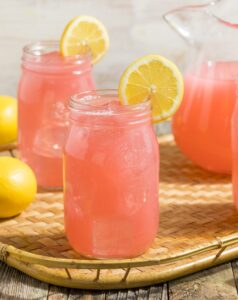 No, it’s not made with pink lemons. The earliest recipe for pink lemonade is from a recipe book from 1892 that called for lemonade to be colored with “fresh or canned strawberry, red raspberry, currant or cranberry juice.” The story goes that pink lemonade was created by a circus worker in the 1850s. Whether or not that is true, lemonade, pink and yellow, seems to be the drink of midways and boardwalks everywhere. See the delicious recipe on the site of Alex and Sonja Overhiser, the couple that cooks.
No, it’s not made with pink lemons. The earliest recipe for pink lemonade is from a recipe book from 1892 that called for lemonade to be colored with “fresh or canned strawberry, red raspberry, currant or cranberry juice.” The story goes that pink lemonade was created by a circus worker in the 1850s. Whether or not that is true, lemonade, pink and yellow, seems to be the drink of midways and boardwalks everywhere. See the delicious recipe on the site of Alex and Sonja Overhiser, the couple that cooks.
Cucumber lemonade
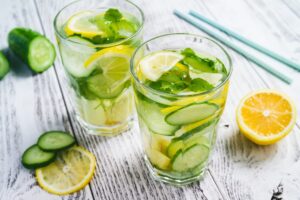
For those of you who don’t think that lemons and cucumbers go together, all we can say it try this delicious recipe. This cucumber lemonade is called “a spa in a glass”. Serve it with a sprig of mint to make it truly refreshing. Once you’ve tried it you’ll realize that there’s no one recipe for the perfect lemonade.
Sparkling lemonade
 If you are one of those people that swears that sparkling is more thirst quenching than flat (and there are many of us) you will love this recipe with added raspberries, strawberries and blackberries for even greater taste payoff.
If you are one of those people that swears that sparkling is more thirst quenching than flat (and there are many of us) you will love this recipe with added raspberries, strawberries and blackberries for even greater taste payoff.
Lavender lemonade
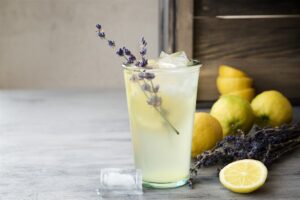 Picture yourself in an English garden, sitting on ornate white metal lawn furniture, watching the birds bathe in their birdbath, sipping your lavender lemonade. This recipe is about as American as you can get, but still transporting.
Picture yourself in an English garden, sitting on ornate white metal lawn furniture, watching the birds bathe in their birdbath, sipping your lavender lemonade. This recipe is about as American as you can get, but still transporting.
Watermelon lemonade
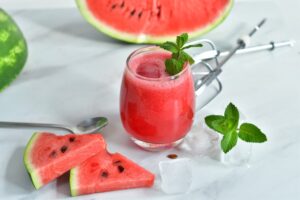 Watermelon is a surprisingly versatile, but often overlooked, fruit. Combine two of the most refreshing summer fruits you can get in this delectable recipe.
Watermelon is a surprisingly versatile, but often overlooked, fruit. Combine two of the most refreshing summer fruits you can get in this delectable recipe.
* * *
You may also like
Go to the Blue Hare homepage for more articles for fabulous women
